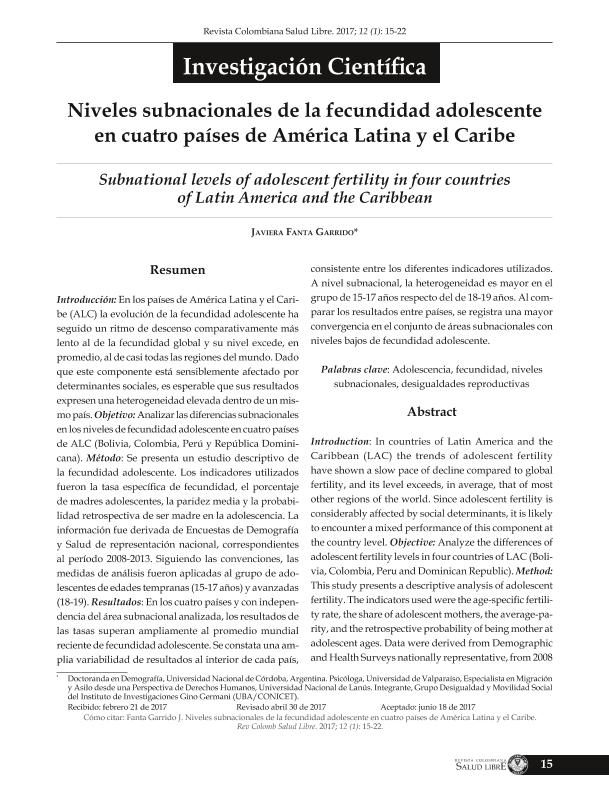Artículo
Introducción: En los países de América Latina y el Caribe (ALC) la evolución de la fecundidad adolescente ha seguido un ritmo de descenso comparativamente más lento al de la fecundidad global y su nivel excede, en promedio, al de casi todas las regiones del mundo. Dado que este componente está sensiblemente afectado por determinantes sociales, es esperable que sus resultados expresen una heterogeneidad elevada dentro de un mismo país. Objetivo: Analizar las diferencias subnacionales en los niveles de fecundidad adolescente en cuatro países de ALC (Bolivia, Colombia, Perú y República Dominicana). Método: Se presenta un estudio descriptivo de la fecundidad adolescente. Los indicadores utilizados fueron la tasa específica de fecundidad, el porcentaje de madres adolescentes, la paridez media y la probabilidad retrospectiva de ser madre en la adolescencia. La información fue derivada de Encuestas de Demografía y Salud de representación nacional, correspondientes al período 2008-2013. Siguiendo las convenciones, las medidas de análisis fueron aplicadas al grupo de adolescentes de edades tempranas (15-17 años) y avanzadas (18-19). Resultados: En los cuatro países y con independencia del área subnacional analizada, los resultados de las tasas superan ampliamente al promedio mundial reciente de fecundidad adolescente. Se constata una amplia variabilidad de resultados al interior de cada país, consistente entre los diferentes indicadores utilizados. A nivel subnacional, la heterogeneidad es mayor en el grupo de 15-17 años respecto del de 18-19 años. Al comparar los resultados entre países, se registra una mayor convergencia en el conjunto de áreas subnacionales con niveles bajos de fecundidad adolescente Introduction: In countries of Latin America and the Caribbean (LAC) the trends of adolescent fertility have shown a slow pace of decline compared to global fertility, and its level exceeds, in average, that of most other regions of the world. Since adolescent fertility is considerably affected by social determinants, it is likely to encounter a mixed performance of this component at the country level. Objective: Analyze the differences of adolescent fertility levels in four countries of LAC (Bolivia, Colombia, Peru and Dominican Republic). Method: This study presents a descriptive analysis of adolescent fertility. The indicators used were the age-specific fertility rate, the share of adolescent mothers, the average-parity, and the retrospective probability of being mother at adolescent ages. Data were derived from Demographic and Health Surveys nationally representative, from 2008 to 2013. According to conventions, the selected measures were applied to early (15-17) and advanced (18-19) ages of adolescence. Results: In the four countries concerned, the results of adolescent fertility rates are far above the average global rate, irrespective of the subnational area examined. In all cases, there is a high variability at the country-level, consistently expressed through the different indicators applied. At the subnational level, the heterogeneity is higher within the group aged 15-17 than in the one aged 18-19. When comparing results between countries, a growing convergence emerges in the set of subnational areas with lower adolescent fertility levels.
Niveles subnacionales de la fecundidad adolescente en cuatro países de América Latina y el Caribe
Fecha de publicación:
12/2017
Editorial:
Impresora Feriva Sa
Revista:
Revista Colombiana de Salud Libre
ISSN:
1900-7841
Idioma:
Español
Tipo de recurso:
Artículo publicado
Clasificación temática:
Resumen
Palabras clave:
Adolescencia
,
Fecundidad
,
Niveles Subnacionales
,
Desigualdades Reproductivas
Archivos asociados
Licencia
Identificadores
Colecciones
Articulos(SEDE CENTRAL)
Articulos de SEDE CENTRAL
Articulos de SEDE CENTRAL
Citación
Fanta Garrido, Javiera; Niveles subnacionales de la fecundidad adolescente en cuatro países de América Latina y el Caribe; Impresora Feriva Sa; Revista Colombiana de Salud Libre; 12; 1; 12-2017; 15-22
Compartir




